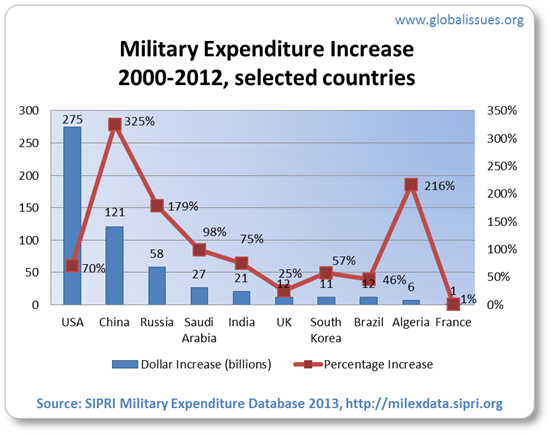
The global financial and economic crisis resulted in many nations cutting back on all sorts of public spending, and yet military spending continued to increase. Only in 2012 was a fall in world military expenditure noted — and it was a small fall. How would continued spending be justified in such an era?
Before the crisis hit, many nations were enjoying either high economic growth or far easier access to credit without any knowledge of what was to come.
A combination of factors explained increased military spending in recent years before the economic crisis as earlier SIPRI reports had also noted, for example:
- Foreign policy objectives
- Real or perceived threats
- Armed conflict and policies to contribute to multilateral peacekeeping operations
- Availability of economic resources
The last point refers to rapidly developing nations like China and India that have seen their economies boom in recent years. In addition, high and rising world market prices for minerals and fossil fuels (at least until recently) have also enabled some nations to spend more on their militaries.
China, for the first time, ranked number 2 in spending in 2008.
But even in the aftermath of the financial crisis amidst cries for government cut backs, military spending appeared to have been spared. For example,
The USA led the rise [in military spending], but it was not alone. Of those countries for which data was available, 65% increased their military spending in real terms in 2009. The increase was particularly pronounced among larger economies, both developing and developed: 16 of the 19 states in the G20 saw real-terms increases in military spending in 2009.
For many in Western Europe or USA at the height of the financial crisis, it may have been easy to forget the global
financial crisis, was primarily a Western financial crisis (albeit with global reverberations). So this helps explains partly why military spending did not fall as immediately as one might otherwise think. As SIPRI explains:
- Some nations like China and India have not experienced a downturn, but instead enjoyed economic growth
- Most developed (and some larger developing) countries have boosted public spending to tackle the recession using large economic stimulus packages. Military spending, though not a large part of it, has been part of that general public expenditure attention (some also call this
Military Keynesianism
- Geopolitics and strategic interests are still factors to project or maintain power:
rising military spending for the USA, as the only superpower, and for other major or intermediate powers, such as Brazil, China, Russia and India, appears to represent a strategic choice in their long-term quest for global and regional influence; one that they may be loath to go without, even in hard economic times
, SIPRI adds.
For USA’s 2012 military expenditure, for example, although there is fall, it is primarily related to war-spending (Iraq and Afghanistan operations primarily). But the baseline defense budget, by comparison, is largely similar to other years (marking a reduction in the rate of increased spending).
By contrast, when it comes to smaller countries — with no such power ambitions and, more importantly, lacking the resources and credit-worthiness to sustain such large budget deficits — many have cut back their military spending in 2009, especially in Central and Eastern Europe.
(Perlo-Freeman, Ismail and Solmirano, pp.1 – 2)
Natural resources have also driven military spending and arms imports in the developing world. The increase in oil prices means more for oil exporting nations.
The natural resource curse
has long been recognized as a phenomenon whereby nations, despite abundant rich resources, find themselves in conflict and tension due to the power struggles that those resources bring (internal and external influences are all part of this).
In their earlier 2006 report SIPRI noted that, Algeria, Azerbaijan, Russia and Saudi Arabia have been able to increase spending because of increased oil and gas revenues, while Chile and Peru’s increases are resource-driven, because their military spending is linked by law to profits from the exploitation of key natural resources.
Also, China and India, the world’s two emerging economic powers, are demonstrating a sustained increase in their military expenditure and contribute to the growth in world military spending. In absolute terms their current spending is only a fraction of the USA’s. Their increases are largely commensurate with their economic growth.
The military expenditure database from SIPRI also shows that while percentage increases over the previous decade may be large for some nations, their overall spending amounts may be varied.

(See also this summary of recent trends, also from SIPRI. The latest figures SIPRI uses are from 2012, and where necessary (e.g. China and Russia), include estimates.)